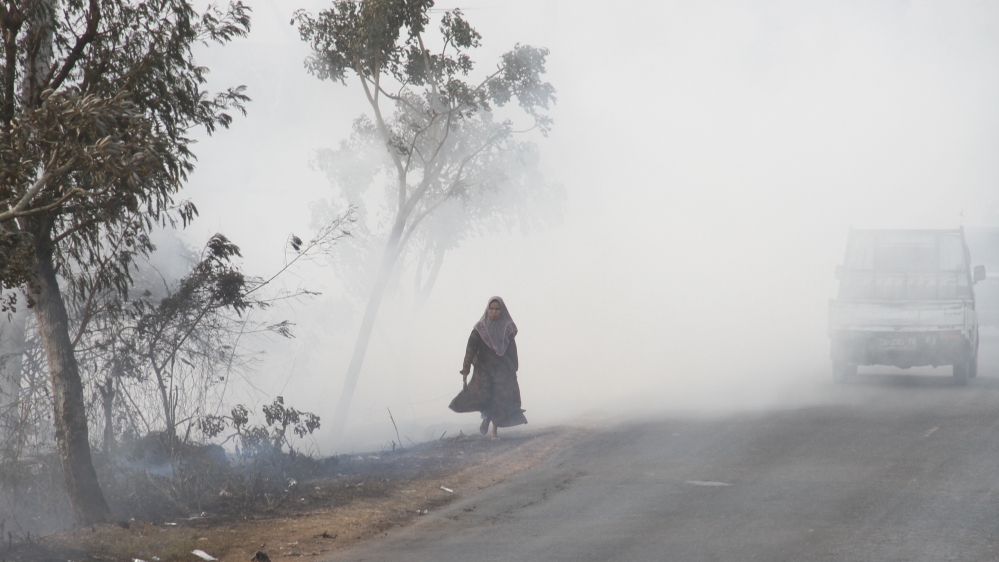By the numbers: Economic impact of Southeast Asia’s haze
Agriculture and healthcare sectors among those bearing cost of worsening air quality in Southeast Asia.

As pollution returns to the skies of Southeast Asia, the economic costs associated with tackling and managing the effects of transboundary haze are also making a comeback.
While the price of 2019’s fires in Indonesia has yet to be quantified, looking back at data from previous years might give Southeast Asian countries a glimpse of the losses they risk suffering again.
Keep reading
list of 4 itemsSlovakia’s PM Fico undergoes new operation amid hopes for his recovery
South Africa’s Ramaphosa signs health bill weeks before election
Gaza lost much more than a hospital when it lost al-Shifa
Historically, two years stand out as being infamous for the intensity of the haze in the region: 1997 and 2015.
“We’re unable to tell right now if it will be worse than previous years. It all depends on how long the haze lasts. At the moment, it has not reached the intensity of 2015 yet,” Helena Varkkey, senior lecturer for the Department of International and Strategic Studies at the University of Malaya told Al Jazeera.
As a percentage of gross domestic product (GDP), the 2015 haze event cost Indonesia 1.9 percent and Singapore 0.17 percent. For Malaysia, data on the economic costs of the 2015 haze was not readily available, but figures for 1997 are considered by researchers to be a useful benchmark.
In Indonesia, where forest fires are the main culprit of the smoke filling the region’s skies and people’s lungs, the immediate economic costs in 2015 totalled 221 trillion Indonesian rupiah ($16.1bn), according to World Bank estimates.
“This is more than twice the reconstruction cost following the [2004] Aceh tsunami,” the World Bank said in a 2016 report.

The Indonesian government under President Joko Widodo, better known as Jokowi, has made efforts to combat the causes of forest burning, but these seem to have fallen short.
Jokowi’s administration spent between $590m and $1.2bn annually on rice field and irrigation expansions since 2015, Andre Aquino, Senior Natural Resources Management Specialist at the World Bank Group told Al Jazeera.
“However, we observe that the underlying factors of the annual and chronic fires remain. Addressing the main driver of fires, which is biomass burning for land clearing, remains a challenge,” Aquino said in an email. Information on what private companies have done to respond to and manage peat fires in Indonesia is scant, said Varkkey.
Most oil palm plantations in Indonesia are managed by Malaysian and Singaporean companies.
“On the Indonesian government side, I’d say that they have been comparatively less prepared after a few years of good weather,” Varkkey said.

“Some of the strict measures Jokowi put into place during the 2015 haze have not been followed through well in the following years.”
In July, Indonesia’s Supreme Court upheld a lower court ruling that held Jokowi liable for the 2015 forest fires resulting in a regional haze.
“Jokowi needs to abide by the court ruling to release information of ownership of land concessions of companies, so that the ownership of burning areas can be public knowledge,” Varkkey said, adding that this can act as a check-and-balance system between the public and the companies.
The World Bank’s Aquino said that public spending could be redirected towards helping farming communities and companies in the fire-prone villages transform their land clearing practices “from burning to mechanized and biomass conversion to energy or organic fertilizer.”
If this happens within the next five years, “there is a window of opportunity where these chronic forest and land fires can be resolved once-and-for-all,” Aquino noted.
He also emphasised the need for strict law enforcement in regards to burning.
Suffer the neighbours
Malaysia’s economic losses from 2015 have not been formally quantified, with the last proper quantification of losses completed only for the 1997 haze, according to Varkkey.
However, a 2018 paper calculated that Malaysia’s costs of treating haze-related illnesses surged 20 times between 1997 to 2013. However, this figure does not account for the change in the population, which grew 38 percent between both years, or inflation.
Meanwhile, Singaporeans in a 2015 survey said they were willing to pay approximately one percent of their annual income for haze-free air all year round.
“Taking into account the estimates from other methods … the total impact on Singapore could easily be over one billion Singaporean dollars ($730m) in a bad haze year,” the researchers wrote.
“Accordingly, Singapore should be willing to invest at least a few hundred million dollars to avert a bad haze year, or a few billion to permanently mitigate haze.”